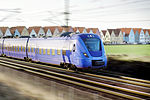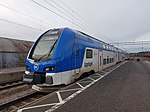Rail transport in Sweden
This article needs additional citations for verification. (March 2016) |
| Sweden | |||||
|---|---|---|---|---|---|
Öresundsbron (7.8 km) | |||||
| Highest elevation | 601 m a.s.l. | ||||
| at | Storlien | ||||
| Lowest elevation | 30 m b.s.l. | ||||
| at | Stockholm City Station | ||||
| |||||
Rail transport in Sweden uses a network of 10,912 kilometres (6,780 mi), the 24th largest in the world.[3] Construction of the first railway line in Sweden began in 1855. The major operator of passenger trains has traditionally been the state-owned SJ, though today around 70% of all rail traffic consists of subsidised local and regional trains for which the regional public transport authorities bear responsibility.[4] Passenger traffic has increased significantly since the turn of the millennium,[5] and in 2019 Sweden ranked number five in the world (as measured in passenger kilometres per capita) and number three in the European union,[5] as well as number six in the world when measured by passenger share.
In 1988, driven by significant deficits at Swedish State Railways, the Swedish parliament pursued a separation strategy that involved partitioning the ownership of rail infrastructure from train operations. This move, which made Sweden the first European country to undertake such a separation, also involved opening the railway system to private train operators, including open-access operators, and introducing competitive bidding for regional service contracts. [6][7]
Sweden is a member of the
Operators
Passenger traffic on Swedish railways consists of commercial long-distance lines as well as regional and local trains, which are always subsidised by the regional public transport authorities.[4] As measured by train kilometres, the commercial lines correspond to 28% of the traffic (in 2016), the rest being subsidised local and regional rail traffic.[4]
The major national commercial passenger train operator is state-owned
The subsidised traffic covering most Swedish railway routes are handled and marketed by the different regional transport authorities, such as
While most current railway lines of Sweden were determined and built by the state, and receive their technical upkeep from the public as well, SJ no longer holds a monopoly on operating and owning passenger trains where such can be run profitably on a commercial basis. Large parts of the rail network serve parts of the country which don't generate enough passenger or cargo traffic to make a profit, and on some of these stretches SJ has held a de facto monopoly until recently (2010, see below in this section). Average speed is an important factor regarding profitability (more distance per hour means more income per hour). All subsidised and commercial traffic is operated on state-owned tracks, except
A decision was made in March 2009 to cancel the monopoly for SJ. By autumn 2009, free competition was allowed on Saturdays and Sundays when there is more room on the tracks, and competition was allowed to a full extent by autumn of 2010. In 2019, the Swedish railways were called 'the most deregulated railways in the world'.[13]
Rail traffic is supervised by the Swedish Transport Administration (Trafikverket), a government agency.
History
The first Swedish railroad for public transport using horse-drawn carriages, the Frykstads railroad in Värmland opened in 1849.
In 1853 the
The main line railways were of major importance for the development of the Swedish industry. The first two main line railways were the Southern, stretching from Stockholm to Malmö in the south, and the Western, to Gothenburg in the west. These line railways were finished between 1860 and 1864. The Northern railway runs parallel to the Baltic coast (but not along it) up to
The construction of the early main lines provided a fast and safe connection from the mines in the north to the rest of Sweden. It also facilitated business (and private) travel, which had earlier required horse-drawn carriages.
, Norway was inaugurated on July 14, 1903. The stretch between Kiruna and Riksgränsen was the first major railway line in Sweden to be electrified in 1915.
Network
- Total: 15006.25 km (includes 3,600 km of privately owned railways)
- double track(2008)
- standard gauge, except for Roslagsbanan and a few heritage railways. (2019).
Unlike the roads, railways in Sweden use left-handed traffic for trains (the same as the metro) because Sweden drove on the left until 1967. Railways did not switch because the engines of the time had the driver's seat on the left side and the signals are normally located to the left and hence are easier to see. Only railways in Malmö and further south have planned right-hand traffic due to their connection with Denmark. However, as signals are placed in both directions on all tracks, it is possible to drive both left- and right-sided at the traffic controller's discretion.
Lines
Main lines
There used to be six main lines (stambanor), all nationally owned:
- Västra stambanan (Western main line), 453 km, Stockholm-Gothenburg through Katrineholm-Hallsberg-Laxå-Falköping
- Östra stambanan (Eastern main line), 216 km, Nässjö-Katrineholm through Mjölby-Linköping-Norrköping)
- Krylbo
- Nordvästra stambanan (Northwestern main line), 209 km, Laxå-Norwegian border through Karlstad-Kil-Charlottenberg
Some lines were upgraded to main lines but have since been downgraded:
- Mittbanan (Norrland cross line), about 500 km, Sundsvall-Norwegian border through Ånge-Östersund
- Inlandsbanan, about 1300 km, Kristinehamn-Gällivare through Mora-Östersund
The naming rationale was that lines built by the state were main lines, but others, such as by private companies, were not. Mainly 1940–1952, most lines were purchased by the state, making the term main line less well-defined.
Today, changes have been made in the terminology reducing the number of main lines to four. The northwestern main line is not considered a main line anymore and has been renamed Värmlandsbanan. The southern main line between Nässjö and Falköping has also been downgraded since what was once part of the Eastern main line (Nässjö - Katrineholm) is now considered a part of the southern one. The Norrland cross line is not a main line anymore, but a regional railway. The northern main line south of Ockelbo refers to a shorter way than the line through Avesta. The East Coast Line (Ostkustbanan) Stockholm-Sundsvall is now considered a main line, since it has the majority of the passenger traffic into Norrland. The Inlandsbanan was considered a main line for a few decades, but is now a tourist railway only. The main lines are still owned by the state, except Inlandsbanan, which is owned by the counties it runs through.
Other lines
Railway links with adjacent countries
- Denmark: same gauge, voltage change 15 kV AC / 25 kV AC - Øresund Bridge and train ferry Göteborg - Frederikshavn.
- overhead lines to be added in 2025.[14]
- Germany: train ferry, same gauge, no electric propulsion on board. Train ferry Malmö - Travemünde, Trelleborg - Sassnitz (Mukran) and Trelleborg - Rostock.[15]
- Norway: same gauge, same voltage (three electric lines and one non-electric)
- Poland: same gauge, train ferry Ystad - Świnoujście, no electric propulsion on board.
Sweden and Norway have the same
These train ferries never have electric overhead lines on board, so diesel must be used to get trains onboard/offboard. Generally locomotives are not transported on these ferries, only train cars.
International passenger trains today (2023) operate on these lines:
- Norway
- From Oslo to Gothenburg and to Stockholm
- From Narvik to Stockholm via Kiruna
- From Trondheim to Storlien
- Denmark
- From Copenhagen via Øresund bridge to Malmö, Stockholm, Gothenburg, Kalmar, and Karlskrona.
- Germany
- From Berlin and Hamburg via Denmark to Malmö and Stockholm
No passenger trains operate between Finland and Sweden, neither through Haparanda/Tornio nor train ferry to Turku. However trains at Haparanda are planned in 2025.[14] No passenger train use any train ferry (abandoned 2020).
Major expansion projects
| Line | Speed | Construction began | Expected start of revenue services |
|---|---|---|---|
| The North Bothnia Line
Norrbotniabanan |
250 km/h (155 mph) | August 2018 (Umeå–Dåva section) | 2024 |
| The West Link
Västlänken |
May 2018 | 2026 | |
| The East Link
Ostlänken |
250 km/h (155 mph) | 2023–2024 (estimated) | 2033–2035 |
| Southeast Link
Sydosstlänken |
160 km/h (100 mph) | 2028–2033 (possible) | ? |
| Gothenburg–Borås Double Tracks | 250 km/h (155 mph)? | Not been decided | |
| Hässleholm–Lund Four Tracks | 250 km/h (155 mph)? | Not been decided |
Gallery
- Selected passenger train operators
-
Snälltåget Passenger cars
-
FlixTrain in the Western Main Line
-
SJ X2000 at Gothenburg Central Station in 2018
-
MTRX at Stockholm Central Station in 2015
-
Pågatåg outside Lund
-
Norrtåg calling at Örnsköldsvik
-
Skånetrafiken Øresundståg calling at Malmö central
-
Upplands lokaltrafikUpptåget calling at Örbyhus
See also
- Rail transport by country
- High-speed rail in Sweden
- Transportation in Sweden
- Rail transport in Europe
References
- ^ a b c d Nelldal, Bo-Lennart, Andersson, Josef, Froidh, Oskar. (2018). Kungliga tekniska högskolan. Resandeflöden på Sveriges järnvägsnätAnalys av utbud och efterfrågan på tågresor TRITA-ABE-RPT-1818 URL: http://kth.diva-portal.org/smash/get/diva2:1251488/FULLTEXT01.pdf
- ^ "Railway passenger transport statistics" (PDF). Europa EU. 8 December 2019. Retrieved 9 January 2021.
- ^ a b c d e f "Bantrafik 2021" (in Swedish and English). 23 June 2022. p. Table 2.1. Archived from the original on 3 February 2023. Retrieved 28 August 2023.
- ^ a b c Transportstyrelsen Resandeflöden på Sveriges järnvägsnät Analys av utbud och efterfrågan på tågresor (in Swedish TSJ 2019-2258. Website URL: https://www.transportstyrelsen.se/4978e1/globalassets/global/publikationer/marknadsovervakning/resandefloden-pa-sveriges-jarnvagsnat20190411.pdf
- ^ a b Eurostat (2021) Statistics Modal split of passenger transport. Data from 2019. https://ec.europa.eu/eurostat/databrowser/view/t2020_rk310/settings_1/table?lang=en
- . Retrieved 19 March 2019.
- ^ "Sweden, 30 years of railway liberalisation". Mediarail.be - Rail Europe News (in French). 2019-05-19. Retrieved 2024-01-23.
- ^ ResRobot Timetables URL: https://tagtidtabeller.resrobot.se/
- ^ MTRX Website URL: https://mtrx.travel/en
- ^ FlixTrain Timetables URL: https://www.flixtrain.se/tidtabeller
- ^ Snälltåget URL: https://www.snalltaget.se/en
- ^ Tågab website URL: https://www.tagakeriet.se/english/
- ^ Söör, Johan (2019). Världens mest avreglerade järnväg. (In Swedish). URL: https://timbro.se/smedjan/varldens-mest-avreglerade-jarnvag/
- ^ a b Laurila-Tornio-Haparanda
- ^ Scandlines Archived 2008-10-22 at the Wayback Machine
External links
![]() Media related to Rail transport in Sweden at Wikimedia Commons
Media related to Rail transport in Sweden at Wikimedia Commons
- Swedish Transport Administration
- Official site of Swedish Railways, Statens järnvägars
- Search engine for all public transport inside Sweden
- Winchester, Clarence, ed. (1936), "Sweden's rail system", Railway Wonders of the World, pp. 1161–1165 illustrated description of the Swedish system in the 1930s









